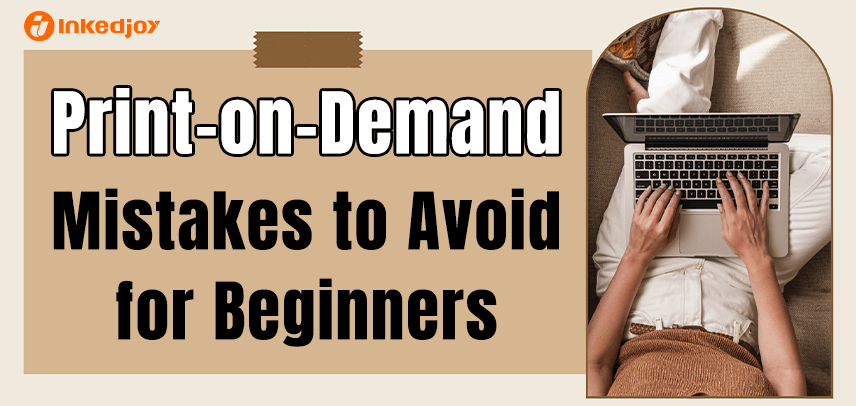
Don't Make These 10 Print-on-Demand Mistakes When You're Starting Out
Print-on-demand is a cool way to turn your designs into real products without having to pay for a bunch of inventory upfront. But a lot of people just starting out make some common mistakes that can stop them before they even get going. Knowing about these mistakes early can help you build a solid business and avoid wasting time and money.
Page overview:
1. Skipping Market Research Before Designing
2. Choosing Cheap, Low-Quality Suppliers
3. Ignoring Copyright and Trademark Issues
4. Creating Designs That Don't Print Well
5. Forgetting About SEO in Product Listings
6. Setting Prices That Don't Make Sense
7. Launching Too Many Products Too Fast
1. Skipping Market Research Before Designing
One of the biggest mistakes is jumping right into designing without knowing what people actually want to buy. A lot of talented artists think their own taste matches what the market wants, but then they find out nobody's interested in their designs.
If you want to do print-on-demand right, spend time figuring out what's popular, what people are buying during different seasons, and what different groups of people are interested in. Look at what your competitors are selling, read customer reviews, and see what people are talking about on social media to find opportunities.
Good market research means looking at things like how often people search for certain keywords, what products are selling well in different categories, and what different groups of people like. This can save you from the disappointment of creating products nobody wants when you know how to do market research.
2. Choosing Cheap, Low-Quality Suppliers
What people think of your business and how happy your customers are depend on how good your items are. People who are just starting out often choose the cheapest sellers. However, this can hurt your business in the long run by making customers unhappy and getting bad reviews.
Good suppliers generally charge more, but their printing is better, their materials are nicer, and they ship faster. Most of the time, people are happy to pay a little more for things that look good and feel good.
You should get samples of the goods you want to sell before you start selling them. Look at how the print looks, how the fabric feels, and how well the item is put together. Putting money into this can pay off in the form of happy customers and better reviews.
3. Ignoring Copyright and Trademark Issues
If you use someone else's intellectual property without permission, you could get your account suspended, face legal trouble, and lose a lot of money. A lot of beginners think they can just use any image they find online or make slight changes to popular characters without any problems.
Copyright protects things like logos, brand names, celebrity photos, movie quotes, song lyrics, and artwork. Even creating designs that are "inspired by" something else can get you in trouble with the people who own the rights.
To build a sustainable business, you need to use your own original designs or artwork that you have the proper license to use. Stock photo websites, creative commons resources, and creating your own artwork are all safe ways to get content without risking copyright infringement.
4. Creating Designs That Don't Print Well
The technical requirements for print-on-demand designs are different from regular digital art or printing. Beginners often create designs with low resolution, the wrong color settings, or elements that don't look good on physical products.
Low-resolution images will look blurry and unprofessional when printed. Vector graphics stay sharp at any size, while raster images need high DPI settings to look good. Also, the colors you see on your screen might not be exactly the same as the colors that come out in the printing process.
Make sure you understand the print areas, safe zones, and bleed areas so your designs don't get cut off or look misaligned. Each product type has its own specific design requirements that you need to follow for the best results.

5. Forgetting About SEO in Product Listings
If people can't find your products online, you won't make many sales. Product titles, descriptions, and tags that aren't optimized can lead to low search rankings and fewer customers finding your products.
To optimize your products, include relevant keywords in your titles and descriptions in a way that sounds natural. Instead of using a generic title like "Funny T-Shirt," try something more specific like "Coffee Lover Gift Shirt for Office Workers."
Using the right tags can help your products show up in relevant searches and in the recommendations that platforms make to users. Research what people are searching for in your target market and use those terms in your product listings.
6. Setting Prices That Don't Make Sense
Pricing mistakes can kill your profits or make your products too expensive compared to the competition. Some beginners set their prices too low to attract customers, but then they don't make any profit. Others set their prices too high without offering enough value, so customers go somewhere else.
When you're setting prices, think about your production costs, platform fees, advertising costs, and how much profit you want to make. Look at what similar products are selling for to see what the market will bear and find the best place to position your products.
You can charge more if your products have unique designs, better quality, or are aimed at a specific group of people. Lower prices can work if you're selling a lot of mainstream designs that appeal to a wide audience.
7. Launching Too Many Products Too Fast
Having a lot of products doesn't guarantee sales. A lot of beginners flood the market with tons of average designs instead of focusing on creating a smaller number of really good products that people will love.
A better approach is to start with 10-20 carefully designed products and then add more based on how well they're selling. This lets you focus on quality, spend more effort on marketing, and get a better sense of what your customers want.
Starting with fewer products also makes it easier to manage your inventory, handle customer service, and run promotions while you're still learning the ropes of the platform.
8. Not Building a Brand
It's hard to grow your business and keep customers coming back if you act like you have no name or face. A lot of people who are new to print-on-demand see it as a way to make quick cash instead of building a brand that people know and trust.
There should be a clear message, a uniform look, and a personality that connects with the people you want to buy from your brand. You can charge more, keep customers coming back, and get people talking about your brand this way.
Make brand guidelines for things like your messaging, color schemes, fonts, and design themes so that all of your goods have the same look and feel. This will help you stand out.
9. Not giving good customer service
Customer service that is good for your business will help it succeed in the long run and keep its good name. Some newbies think that automated systems can do everything, but customers will remember the human touch more than anything else.
Quickly answer customer questions, let them know how their orders are coming along, and be polite when they complain or want to return something. People who are pleased with your business will buy from you again and tell their friends about it.
10. Not Being Patient
Print-on-demand success usually doesn't happen overnight. A lot of beginners expect instant results and give up before their business has a chance to gain momentum. Building a profitable business takes consistent effort, learning, and patience.
To achieve long-term success, you need to treat print-on-demand like a real print-on-demand business that requires hard work, planning, and ongoing effort, rather than a passive income source that doesn't require much attention.
Start Your Print-on-Demand Journey the Right Way
By avoiding these common mistakes, you can set yourself up for success in the competitive world of print-on-demand. Focus on quality over quantity, do your research before you start designing, and build real connections with your target audience to create a lasting, profitable business.



